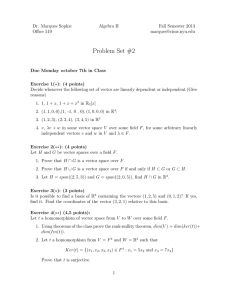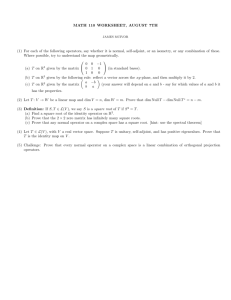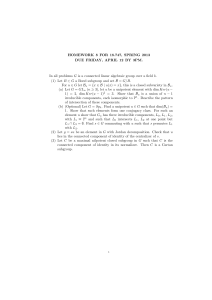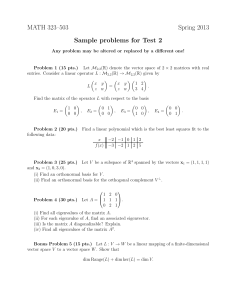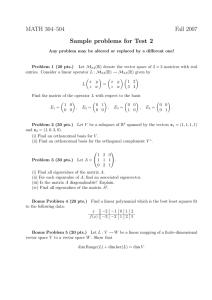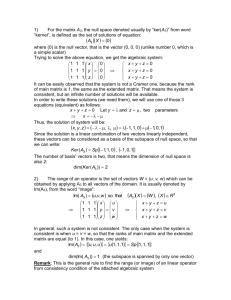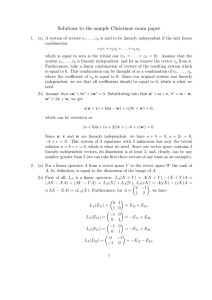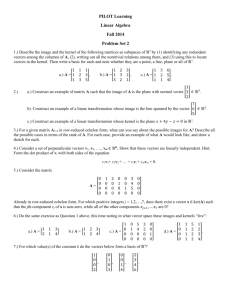Problem Set #4
advertisement
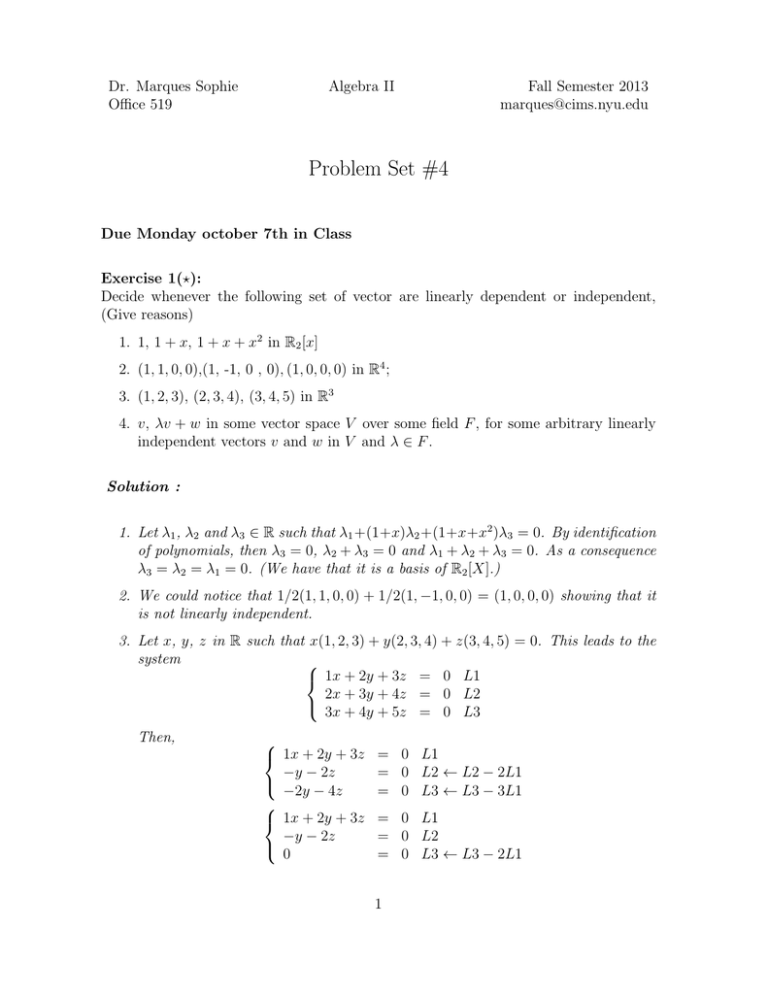
Dr. Marques Sophie
Office 519
Algebra II
Fall Semester 2013
marques@cims.nyu.edu
Problem Set #4
Due Monday october 7th in Class
Exercise 1(?):
Decide whenever the following set of vector are linearly dependent or independent,
(Give reasons)
1. 1, 1 + x, 1 + x + x2 in R2 [x]
2. (1, 1, 0, 0),(1, -1, 0 , 0), (1, 0, 0, 0) in R4 ;
3. (1, 2, 3), (2, 3, 4), (3, 4, 5) in R3
4. v, λv + w in some vector space V over some field F , for some arbitrary linearly
independent vectors v and w in V and λ ∈ F .
Solution :
1. Let λ1 , λ2 and λ3 ∈ R such that λ1 +(1+x)λ2 +(1+x+x2 )λ3 = 0. By identification
of polynomials, then λ3 = 0, λ2 + λ3 = 0 and λ1 + λ2 + λ3 = 0. As a consequence
λ3 = λ2 = λ1 = 0. (We have that it is a basis of R2 [X].)
2. We could notice that 1/2(1, 1, 0, 0) + 1/2(1, −1, 0, 0) = (1, 0, 0, 0) showing that it
is not linearly independent.
3. Let x, y, z in R such that x(1, 2, 3) + y(2, 3, 4) + z(3, 4, 5) = 0. This leads to the
system
1x + 2y + 3z = 0 L1
2x + 3y + 4z = 0 L2
3x + 4y + 5z = 0 L3
Then,
1x + 2y + 3z
−y − 2z
−2y − 4z
1x + 2y + 3z
−y − 2z
0
= 0 L1
= 0 L2 ← L2 − 2L1
= 0 L3 ← L3 − 3L1
= 0 L1
= 0 L2
= 0 L3 ← L3 − 2L1
1
Then taking z = 1, y = −2 and x = −2 × (−2) − 3 = 1 we get x(1, 2, 3) +
y(2, 3, 4) + z(3, 4, 5) = 0. So that there are linearly dependent.
4. Let x and y ∈ F such that xv + y(λv + w) = 0. Then, (x + λy)v + yw = 0, since
v and w are linearly independent then x + λy = 0 and y = 0 then x = 0 and v
and v + w are linearly independent.
Exercise 2(??):
Let H and G be vector spaces over a field F .
1. Prove that H ∩ G is a vector space over F .
2. Prove that H ∪ G is a vector space over F if and only if H ⊂ G or G ⊂ H.
3. Let H = span((2, 53)) and G = span((2, 0, 5)) in R3 , find H ∩ G.
Solution :
1. First, 0 ∈ H ∩ G so H ∩ G is not empty. Let α , β ∈ F , u and v ∈ H ∩ G.
αu + βv belongs to H but also to G since u and v ∈ H and also in G and both
are vectors space. Then H ∩ G is a supspace of H so a vector space.
2. The ”only if” part is obvious since H ⊂ G implies H ∪ G = G and G ⊂ H implies
H ∪ G = H which are vector space by assumption.
Let’s prove the converse, suppose that H ∪G is a vector space and by contradiction,
that H ( G and G ( H, then there are an element of h ∈ H which is not in G and
an element g ∈ G which is not in H. Then, consider the element h + g then since
G ∪ H is a vector space h + g ∈ H ∪ G, so h + g ∈ H or h + g ∈ G. If h + g ∈ H
then g ∈ H contradiction similarly if h + g ∈ G then h ∈ G contradiction.
3. Let (x, y, z) ∈ H ∩ G, then there are reals r and s such that (x, y, z) = r(2, 5, 3)
and (x, y, z) = s(2, 0, 5). Then r(2, 5, 3) = s(2, 0, 5) implies r = s = 0 and clearly
{0} ⊂ H ∩ G. Then, H ∩ G = {0}
Exercise 3(?):
Is it possible to find a basis of R3 containing the vectors (1, 2, 5) and (0, 1, 2)? If yes,
find it. Find the coordinates of the vector (3, 2, 1) relative to this basis.
Solution :
It is possible because clearly the two vectors are linearly independent. Let (a, b, c) ∈ R3
such that (1, 2, 5), (0, 1, 2) and (a, b, c) form a base of R3 . This is equivalent in requiring
that for any x, y, z ∈ R, x(1, 2, 5) + y(0, 1, 2) + z(a, b, c) = 0 implies x = 0, y = 0 and
z = 0. Let investigates on the equation x(1, 2, 5) + y(0, 1, 2) + z(a, b, c) = 0. This is
2
equivalent to the system
x + az
= 0
2x + y + bz = 0
5x + 2y + cz = 0
then x = −az and y = (2a − b)z and −5az + 2(2a − b)z + cz = 0 then (−a − 2b + c)z = 0.
If we choose a = 0, then x = 0, if b = 0, then y = 0 and c = 1 implies z = 0, for any x,
y, z ∈ R. So, (0, 0, 1), (1, 2, 5), (0, 1, 2) is a basis. So there are reals x, y and z, such
that (3, 2, 1) = x(0, 0, 1) + y(0, 1, 2) + z(1, 2, 5), that is verifying the system:
z
= 3
y + 2z
= 2
x + 2y + 5z = 1
Then z = 3, y = 2 − 2 × 3 = −4 and x = 1 − 2 × (−4) − 5 × 3 = −6. Then
(3, 2, 1) = −6(0, 0, 1) − 4(0, 1, 2) + 3(1, 2, 5)
Exercise 4(??):
Let t a homomorphism of vector space from V to W over some field F .
1. Using theorems seen during the class, prove the rank-nullity theorem,
dim(V ) = dim(ker(t)) + dim(Im(t))
2. Let t a homomorphism from V = F 4 and W = F 2 such that
Ker(t) = {(x1 , x2 , x3 , x4 ) ∈ F 4 : x1 = 5x2 and x3 = 7x4 }
Prove that t is surjective.
3. Prove that there does not exist homomorphism t of vector space from F 5 to F 2
such that ker(t) = {(x1 , x2 , x3 , x4 , x5 ) ∈ F 5 : x1 = 3x2 and x3 = x4 = x5 }.
Solution :
1. It is just a combination of the theorem stating that dim(V /V 0 ) = dim(V ) −
dim(V 0 ), for any V 0 subspace of V and of the isomorphism V /ker(f ) ' Im(f ).
2. To prove that t is surjective is equivalent to prove that dim(Im(t)) = dim(W ) = 2
or equivalently by the previous question that dim(ker(f )) = dim(V )−dim(Im(f )) =
4 − 2 = 2. But, we can prove easily that (5, 1, 0, 0) and (0, 0, 7, 1) is a basis of
Ker(t), indeed ker(t) = Span((5, 1, 0, 0), (0, 0, 7, 1)) and dim(ker(t)) = 2.
3. We notice that ker(t) = Span((3, 1, 0, 0, 0), (0, 0, 1, 1, 1)) then dim(ker(t)) = 2,
but then dim(Im(t)) = dim(F 5 ) − dim(ker(t)) = 3 > dim(F 2 ), a contradiction.
So there is no such isomorphism.
3
Exercise 5(??):
Suppose that {vi : i = 1, ..., m} is an orthonormal set in Rn , i.e.,
1 if i = j
vi .vj =
0 if i 6= j
For any v = (v1 , ..., vn ) and v 0 = (v10 , ..., vn0 ) ∈ Rn , we define v.v 0 = v1 v10 + ... + vn vn0 ∈ R,
called the scalar product of v and v 0 . (We notice that v.v = v12 + ....vn2 is positive.
1. Show that {vi ; i = 1, ..., m} are linearly independent.
2. Show that, if there exists a nonzero vector v such that v.vi = 0 for i = 1, ..., m,
then we can enlarge {vi : i = 1, ..., m}to a bigger orthonormal set.
3. Challenge: Suppose n ≥ 2, let v1 ∈ Rn construct a non zero vector v2 such that
v1 .v2 = 0. (Hint: consider a element v linearly independent with v1 and construct
v2 with this element, use question 4. of Exercise 1.) More generally, if we take
v1 , ..., vm an orthonormal set m < n, construct a non zero vector vm+1 such that
vi .vm+1 = 0 for any i.
Solution :
1. Let λi ∈ R such that λ1 v1 + ... + λm vm = 0, by multiplying the previous equality
by vi for any i ∈ {1, ...., m} and using the relation between the v 0 s, we get λi = 0
2. Follows directly from the previous question, clearly by 1., {vi , v|i = 1, ..., m}
√ are
+
linearly independent. Then v.v = α for some α ∈ R , considering vm+1 = 1/ αv,
we get also vm+1 .vm+1 = 1.
3. Consider v ∈ R which is linearly independent with v1 , consider v2 = v − v1 .vv1 .
(Take vm+1 = v − v1 .vv1 − ....vm .vvm .)
4
